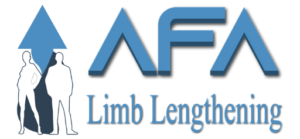When the bone breaks, new bone formation naturally begins and bone union occurs to heal the fracture. Lengthening is applied using the bone’s union property. It occurs by breaking the bone from the specified area and separating the fracture ends at the optimal level. Thus, new bone continues to form in the space in the separation area. When the cavity is filled with new bone tissue and the union is completed, the desired level of bone lengthening is achieved.
Lengthening Surgery
Osteotomy (bone cut) is applied during the lengthening surgery. Osteotomy is the cutting of the bone from the surgically determined area. After the bone is separated, an internal or external fixator is applied for stabilization and lengthening.
After surgery, the patient stays in the hospital for five to seven days. Extension usually does not begin during this period. Extension will begin 5 to 7 days after surgery. The time after surgery and before the start of the lengthening is called the latency period. For the callus (new bone) to begin to form at the fracture site, it is necessary to wait a few days before lengthening.
Distraction Phase
Distraction phase is the period in which the bone is elongated. During this time, the external or internal fixator will gradually lengthen the bone by about one millimeter per day.
Lengthening is done manually with external fixators and the lengthening amount is approximately one millimeter (mm) per day, but lengthening can be more slowly or faster depending on the tolerance of the bone and soft tissues and complications. To make the lengthening more tolerable, one millimeter extension per day is divided into four. Quarter millimeter lengthening are applied a total of four times at certain times of the day.
Lengthening with internal nails (Precice 2 and STRYDE) is done using an external remote control (ERC) device. The patient is taught how to use the remote control by the surgeon and device specialists. Usually four times a quarter millimeter lengthening is achieved by 1 mm per day.
During the lengthening period, conditions such as tissue tension, gait disturbance, pain and swelling may occur. Physical therapy is required to prevent these complications. Physical therapy is one of the most important components of the lengthening process and is generally recommended five days a week. Apart from physical therapy, home exercises that the patient does on his own are also important. The exercise program given should be applied completely.
Consolidation Phase
The consolidation phase begins when the patient reaches the desired length. The consolidation process is the period between the end of the extension and the complete union of the new bone tissue formed. No further adjustment or lengthening is made in the fixator. The fixator or internal nail is used in the body until the soft bone tissue regains its former hardness will continue to stay for support.
Physical therapy and exercises should continue during the consolidation process. Exercises should not be abandoned in terms of speed and quality of recovery. When complete union is achieved and the doctor confirms this by looking at the x-ray, internal nail or external fixator removal surgery can be performed.


[…] segments. An external or internal fixation device is used to stabilize the bone and facilitate the gradual lengthening process. Over time, new bone tissue fills in the gap created by the distraction, resulting in increased […]
[…] primary technique used in limb lengthening procedures is called distraction osteogenesis. Here are the key steps involved in limb lengthening bone […]